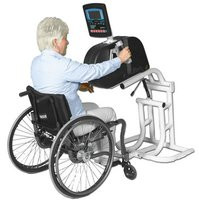 4th Aug 2015
4th Aug 2015
Active Passive Trainers for Physical Therapy
When someone is wheelchair bound, it can take a lot of adjustments to keep their body moving. The work involved to keep mobile may discourage some from attempting to exercise, but the truth is wheelchair users have an even greater need for exercise. Keeping muscles strong and limber will help patient’s maintain proper posture when seated in their wheelchair. Also, maintaining strength and flexibility helps wheelchair users keep more of their independence and in doing so increase their quality of life. Working with a physical therapist to establish an exercise regimen will help wheelchair bound patients increase their activity level. One of the tools a physical therapist will use to help wheelchair bound patients exercise is an Active/Passive Trainer.
Active Passive Training Machines
Active/Passive Trainers are great tools for patients with every little active function. When someone is stationary a lot, which wheelchair users are, it becomes important to have equipment that allows patients to exercise without great effort, move their limbs through ranges of motion while also helping them increase their strength. The Active/Passive Trainer works on the premise that as the person fatigues, the computer processor senses a change in the amount of movement and force by the patient and the interactive motor then picks up the difference, lowering the workload for the patient.
We all know exercise has many benefits. Exercise helps people maintain strength and flexibility, increase circulation, improve balance and coordination, and strengthen the heart and lungs. These benefits are critical components in the quality of life for wheelchair bound patients. However, finding exercise that is accessible is a challenge for people who use a wheelchair. Using an active/passive trainer allows those in a wheelchair to exercise in a way that is modified to their body’s capabilities and needs, but still reap the benefits found in conventional exercise regimens.
Benefits of Active/Passive Machines
- The machine may be placed directly in front of the wheelchair, where the patient’s feet can be placed in the straps and they may pedal their legs, actively working their lower body.
- With the passive pumping action of the limbs, patients are able to move through the range of motion of the limbs, without expending a lot of effort.
- The pumping action, either active or passive, helps the body’s circulation and lowers edema in feet or legs.
- The machine helps increase a patient’s range of motion, loosening and stretching not only the muscles, but tendons and ligaments
- Active/Passive machines improve motor recovery and cardiovascular health simultaneously.
Independence and the ability to maintain it are common concerns for wheelchair bound patients. Active/Passive trainers empower wheelchair bound patients to take charge of their own mobility. Success with physical therapy treatment is largely dependent on patient compliance and participation. Tools like Active/Passive Trainers help wheelchair bound patients regain a daily activity that some have thought they lost: exercise. And the more patients are encouraged and inspired to move their body, the better their quality of life and ability to maintain their independence will improve.
For more information about Active Passive Trainers and Upper Body Exercisers see ProHealthcareProducts.com.







